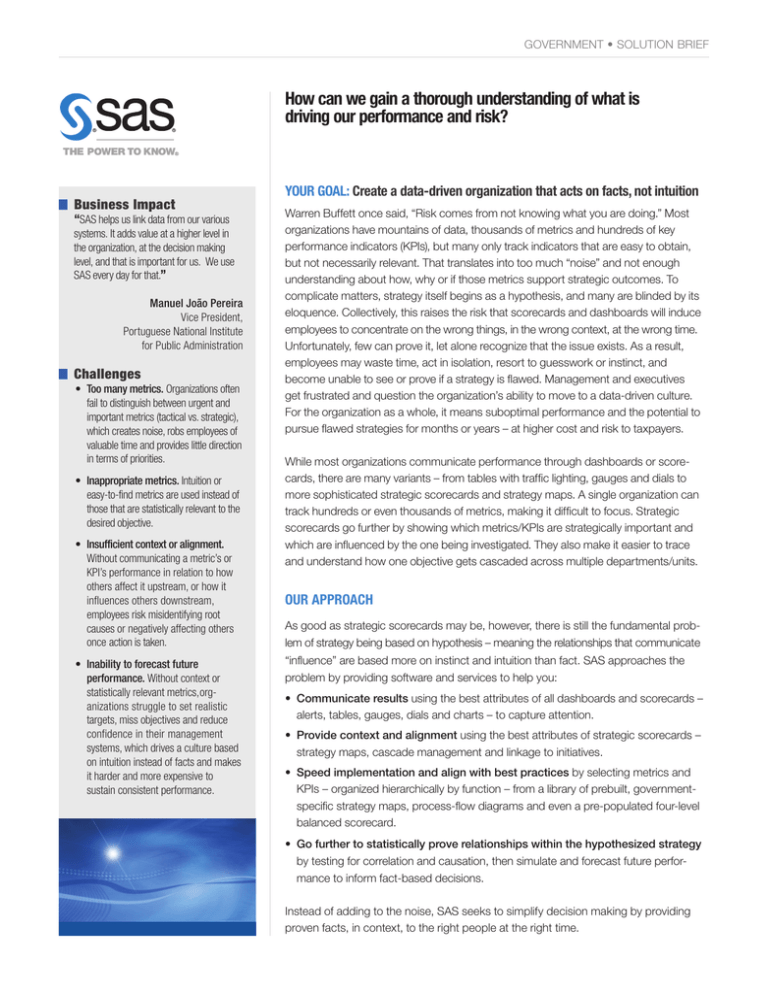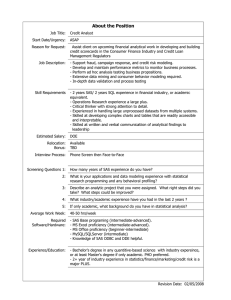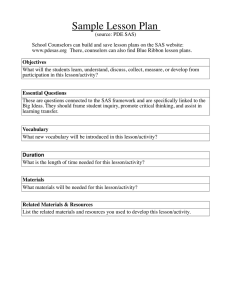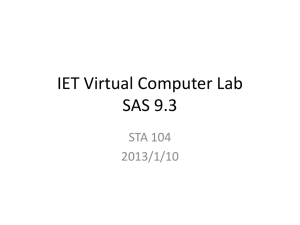
GOVERNMENT • SOLUTION BRIEF
How can we gain a thorough understanding of what is
driving our performance and risk?
Business Impact
“SAS helps us link data from our various
systems. It adds value at a higher level in
the organization, at the decision making
level, and that is important for us. We use
SAS every day for that.”
Manuel João Pereira
Vice President,
Portuguese National Institute
for Public Administration
Challenges
• Too many metrics. Organizations often
fail to distinguish between urgent and
important metrics (tactical vs. strategic),
which creates noise, robs employees of
valuable time and provides little direction
in terms of priorities.
• Inappropriate metrics. Intuition or
easy-to-find metrics are used instead of
those that are statistically relevant to the
desired objective.
• Insufficient context or alignment.
Without communicating a metric’s or
KPI’s performance in relation to how
others affect it upstream, or how it
influences others downstream,
employees risk misidentifying root
causes or negatively affecting others
once action is taken.
• Inability to forecast future
performance. Without context or
statistically relevant metrics,organizations struggle to set realistic
targets, miss objectives and reduce
confidence in their management
systems, which drives a culture based
on intuition instead of facts and makes
it harder and more expensive to
sustain consistent performance.
YOUR GOAL: Create a data-driven organization that acts on facts, not intuition
Warren Buffett once said, “Risk comes from not knowing what you are doing.” Most
organizations have mountains of data, thousands of metrics and hundreds of key
performance indicators (KPIs), but many only track indicators that are easy to obtain,
but not necessarily relevant. That translates into too much “noise” and not enough
understanding about how, why or if those metrics support strategic outcomes. To
complicate matters, strategy itself begins as a hypothesis, and many are blinded by its
eloquence. Collectively, this raises the risk that scorecards and dashboards will induce
employees to concentrate on the wrong things, in the wrong context, at the wrong time.
Unfortunately, few can prove it, let alone recognize that the issue exists. As a result,
employees may waste time, act in isolation, resort to guesswork or instinct, and
become unable to see or prove if a strategy is flawed. Management and executives
get frustrated and question the organization’s ability to move to a data-driven culture.
For the organization as a whole, it means suboptimal performance and the potential to
pursue flawed strategies for months or years – at higher cost and risk to taxpayers.
While most organizations communicate performance through dashboards or scorecards, there are many variants – from tables with traffic lighting, gauges and dials to
more sophisticated strategic scorecards and strategy maps. A single organization can
track hundreds or even thousands of metrics, making it difficult to focus. Strategic
scorecards go further by showing which metrics/KPIs are strategically important and
which are influenced by the one being investigated. They also make it easier to trace
and understand how one objective gets cascaded across multiple departments/units.
OUR APPROACH
As good as strategic scorecards may be, however, there is still the fundamental problem of strategy being based on hypothesis – meaning the relationships that communicate
“influence” are based more on instinct and intuition than fact. SAS approaches the
problem by providing software and services to help you:
• Communicate results using the best attributes of all dashboards and scorecards –
alerts, tables, gauges, dials and charts – to capture attention.
• Provide context and alignment using the best attributes of strategic scorecards –
strategy maps, cascade management and linkage to initiatives.
• Speed implementation and align with best practices by selecting metrics and
KPIs – organized hierarchically by function – from a library of prebuilt, governmentspecific strategy maps, process-flow diagrams and even a pre-populated four-level
balanced scorecard.
• Go further to statistically prove relationships within the hypothesized strategy
by testing for correlation and causation, then simulate and forecast future performance to inform fact-based decisions.
Instead of adding to the noise, SAS seeks to simplify decision making by providing
proven facts, in context, to the right people at the right time.
THE SAS® difference: Intelligent scorecarding
What if you could ...
Most dashboard and scorecard applications let organizations communicate results using
alerts, tables, gauges, dials and charts to capture attention. Most strategic scorecards
add context and alignment through strategy maps, cascade management and linkage
to initiatives. Only SAS delivers all this and more by applying business analytics to dashboarding and scorecarding so that measures and cause-and-effect relationships are no
longer just a perception, but are validated with evidence. SAS provides:
• Correlation techniques that enable you to statistically:
– Prove which metrics are truly valid and “key.”
– Prove how much one metric influences another.
– Prove relationships within a hypothesized strategy.
– Simulate and forecast future performance for consistent, fact-based decisions.
• The power of SAS Analytics in an easy-to-use, point-and-click environment that
gives you confidence in your analysis, so you can rely on facts, not instincts.
In short, SAS delivers intelligent scorecarding to improve efficiency, accuracy and
speed, whether your scorecard is tactical or strategic. What’s more, the SAS solution
also integrates with other SAS solutions to provide additional, proven insights on risk,
cost, customers, quality, suppliers, employees, IT and the environment.
CASE STUDY: Portuguese National Institute for Public Administration (INA)
Situation
The INA needed a system to integrate data from three different transactional
sources and use it to provide business intelligence to get an enhanced view of
management responsibilities, review performance, gain a better understanding of
constituents and ultimately, to help the leaders of Portuguese public administration
make change happen.
Solution
Reduce noise
What if you could prove which metrics
were truly key and eliminate the ones that
were irrelevant?
Get to the root cause of a
problem
What if you could prove how metrics
influence and are influenced by others so
you could avoid decisions that could have
a negative impact on others?
Improve alignment and
communication
What if you could easily see how all
objectives are adapted as they cascade
throughout organizational units by ensuring
that all parts of the organization are “flying
in formation” toward the same goal?
Reduce cost/risk while improving
agility/competitiveness
What if you could prove that a strategy
was flawed months or years ahead of
traditional methods?
Accurately simulate and forecast
future performance
What if you could create a culture that
delivers consistent, fact-based decisions
and results?
You can. SAS gives you
THE POWER TO KNOW®.
SAS delivered an intelligent scorecarding solution that enabled the INA to:
• Integrate data from an Oracle database, from SAP R/3 transactional data
and from several other information systems.
• Monitor, manage and forecast its KPIs.
• Help administrators across the country design objectives and review
performance with:
– An information management board for each of the country’s public hospitals.
– Balanced scorecard initiatives for the country’s police departments.
Results
• Strategic information is provided more quickly and more accurately.
S A S FAC T S
• SAS has been in business since 1976
and today has customers at more than
50,000 sites worldwide.
• Public sector organizations in more
than 80 countries use SAS.
• All 15 major US federal departments
rely on the power of SAS software,
and approximately 85 percent of
independent US government agencies
and commissions use SAS.
• Executive-level dashboards with drill-down capability lets top administrators in all
cabinets extract meaning from the information in support of strategic decisions.
• With SAS’ predictive capabilities, the INA is “actually learning from the past, and
the insights from SAS offer continuous learning.”
SAS Institute Inc. World Headquarters Learn more about SAS software
and services for government:
www.sas.com/government
+1 919 677 8000
To contact your local SAS office, please visit: www.sas.com/offices
SAS and all other SAS Institute Inc. product or service names are registered trademarks or trademarks of SAS Institute Inc. in the USA
and other countries. ® indicates USA registration. Other brand and product names are trademarks of their respective companies.
Copyright © 2011, SAS Institute Inc. All rights reserved.105240_S64928.0611



